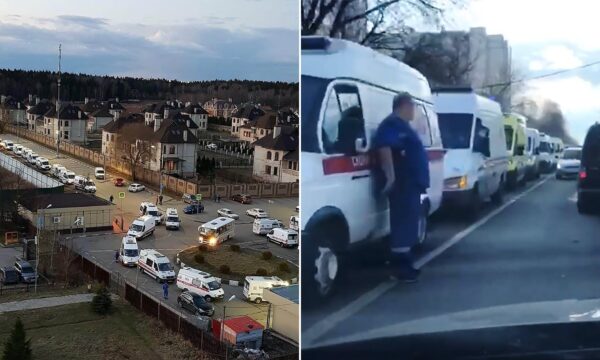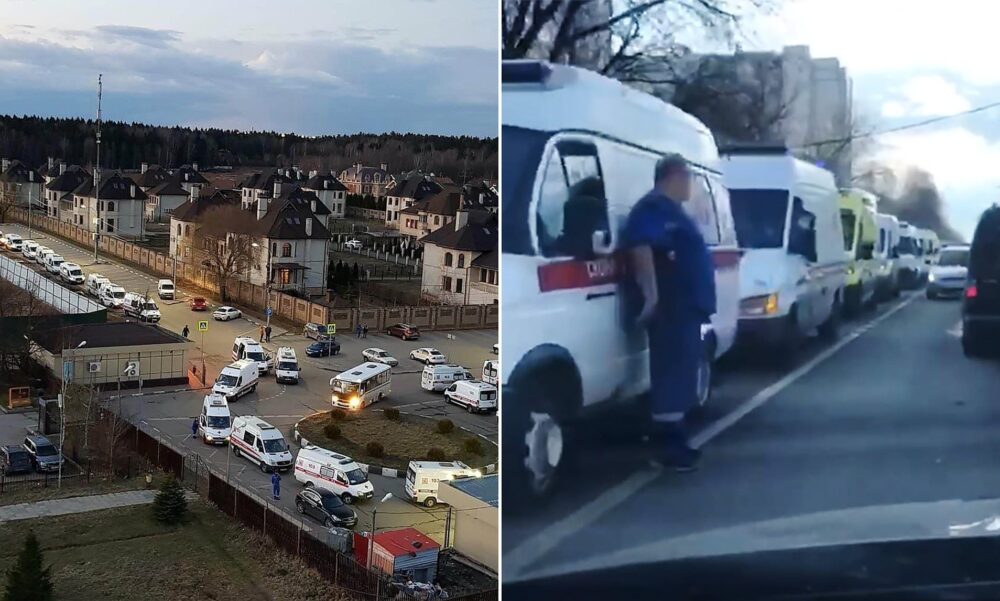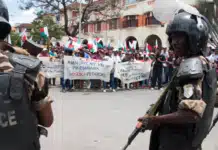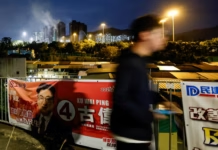Within days, Russia will have the second highest number of confirmed Covid-19 cases in the world, second only to the US
Rob Jones ISA
Already over 260,000 cases, the number is currently increasing by 10–12000 a day.
At the epicenter is Moscow, a city with a population approaching 15 million, currently recording over half of the infections. Officially, however, the number of fatalities is low compared to other countries, at just over 2300, which the Health Minister claims is due to Russia’s “exceptionally precise” approach to recording deaths.
Many doubt the accuracy of these figures. Even the Mayor of Moscow, Sergei Sobyanin, who has also been appointed to oversee the national response to the crisis, says there are about 300,000 infected in Moscow alone. RosStat, the state statistics agency, reports that the increase in Moscow’s death rate in April over the past average for that month is almost three times more than the number of reported Coronavirus fatalities. Another report suggests that in Moscow, 60% of those who die with the Coronavirus are recorded as having died from other illnesses. The capital at least has a relatively modern health and monitoring system. In other parts of the country, information will be far from complete.
On 27th April, hundreds of oil-workers in the Far North Republic of Yakutia organized a spontaneous protest against their employer, the giant GasProm, complaining they were having to work without protection from the virus before travelling home to their families. Reluctantly, management agreed to test them, 3,500 returned positive results. They then claimed that the results were preliminary, and only 600 were infected. Yet over two weeks later, there are still only just over 600 cases registered in the whole republic.

Apocalypse in Caucasia
In the Southern Republic Ingushetia, one of the poorest and most densely populated in Russia, official statistics say there are 1,372 cases. One of the first to die of the disease here was the Republic’s Chief Mufti. The local government is so discredited by corruption that when it warns of the dangers of the disease, no-one believes it.
In the neighbouring Republic, Chechen dictator Ramzan Kadyrev, stopped travel to and from the rest of Russia at the first signs of the virus. In response the Federal Army organised ‘maneouvres’ close to the border apparently to warn him not to go too far. Kadyrev has threatened to shoot anyone who breaches Coronavirus quarantine.
From Dagestan, the largest of the North Caucasian republics with a population of nearly three million, a report carried by the Meduza media resource paints an apocalyptic picture. Officially, there are 3,095 infected, yet there have been only 25,000 tests available. It is claimed, at the time of writing, that there have been just 26 deaths in the Republic, but doctors report that over 25 medical staff alone have died.
In some of the numerous mountain settlements, where the population is mainly elderly and there are usually no medical services, local experts say that often between a third and a half of the population is ill. One doctor sent a video appeal to the Head of the Republic in which, between coughing fits, he reported that normally there would be 15 burials a year from his town, but in March and April, 12 were buried. In another town of 21000, a local doctor estimated that a third of the population had been infected. In the Republican Capital Makhachkala, hospital doctors report that only 20–30% of medical staff are at work, and people who phone for an ambulance are told there is a 24-hour wait. One patient was informed that there were 400 people in the queue!
Austerity healthcare
There have been a significant number of VIPs from singers and actors, to the Prime Minister, Deputy Head of the President’s Administration and now President Putin’s spokesman who have tested positive. They have all received first class treatment in Moscow’s hospitals.
Not so for a large part of the rest of the population. Since 2012, Russia’s health system has been devastated by cut-backs. Hundreds of hospitals have been ‘optimised’ — that is, closed, and the number working in the healthcare system almost halved. In Moscow alone, out of 4800 beds for infectious illnesses, 2200 have been removed since 2012. One whole ‘Infectious disease’ hospital with 570 places was closed in 2015, which makes the decision to rush build a new hospital for Coronavirus patients for 500 people an incredible waste of money.
Now, to provide staff to deal with the virus, second and third year medical students are being sent to work long shifts with no pay. At the notorious Kommunarko hospital in Moscow, students talk of working 24 hour shifts –one student with one professional nurse looking after 60 patients.
Reports are widespread of medical staff refusing to work. In the Baltic enclave of Kaliningrad, at least 350 staff are said to have refused to work in such dangerous conditions. Nursing staff at the Kommunarko also complain they have resigned after not being paid. The Head Doctor, who himself caught the disease denied this was the case, but it turns out they were agency nurses.
Now, social networks are full of protests by medical workers about the bonuses promised by Putin in his televised addresses for those working with Coronavirus patients. He said that they would get between 300 and 1000 euros extra. Yet regional authorities have only paid out 20% of this money. Doctors who have had to self-isolate after treating patients have instead had their pay cut. One Doctor who says her wage is normally 450 euros a month, received just 180 after being in isolation for two weeks. Others report receiving an increase of just 10 euros — not enough to cover the cost of a couple of black market masks.
As if to add insult to injury, now two hospitals and two hospices have burst into flame. In at least three of these cases, ventilators produced in a rush in a Russian factory to replace the older German models that can no longer be purchased due to sanctions have caught fire. Ten people have died in this way.
The regime in crisis
Even before the virus, support for Putin was beginning to ebb away. The economy was beginning to enter another downturn. In order to extend his rule for another twelve years, the Kremlin proposed changing the Constitution. This was due to be put to a “people’s vote” on April 22nd. The plan was to hold the vote as soon as possible, to allow for the ‘coronation’ of the life-long leader, rushed through before the economic collapse became too evident.
But instead of a ‘coronation’ they got the coronavirus. For weeks they claimed it wouldn’t affect Russia. As the virus raged in Italy, Russian state TV reported on how bad the crisis was in Europe, but ‘we are prepared to meet this attack from abroad’. As the virus began to spread, all the institutions that prop up the Kremlin pretended they were immune.
Employers denied workers the right to work at home, because ‘the virus is imaginary’. The army, at the Kremlin’s insistence, continued to practice the military parade to celebrate the 75th Anniversary of the end of the War– as a result at least 400 soldiers were infected. Even after the self-isolation regime was introduced, the church refused to recognize the need for social distancing. Even as late as Easter, marked in Russia on 19th April, they held services. Archpriest Smirnov, notorious for his reactionary sexism, claimed that the virus was “an extremely useful phenomenon, those who gave their lives were helping others to understand important Christian qualities”. Sad to report that he himself was then hospitalized with the virus. A number of his colleagues were not so lucky, several senior churchmen have died, leaving a number of important churches as virulent centres of the virus spread.
Putin announces a ‘non-working week’
Eventually the Kremlin acted, by in effect not acting. Addressing Russians on TV Putin announced that from March 28th there would be a ‘non-working week’ in which all but essential workers would be on paid holiday, with the state offering some financial support to employers.
Significantly, he announced that each of Russia’s 85 Regional Heads would be responsible for the fight against the virus in their region. After twenty years of concentrating all power in his hands, he suddenly delegated dealing with one of the worst crises faced by Russia to people who until then had been trained to simply obey his orders.
There is, of course, a logic to having a different approach in such a large country. But this has just fuelled mistrust between regions. Moscow, a ‘state within a state’ set the tone with the most vigorous measures. It was joined by the Moscow region — between them covering an area and a population one and a half times that of Belgium. Anyone over 65 was told to self-isolate at home, only those who worked in essential work should stay working and anyone who wanted to leave home for any reason was supposed to apply every time for a QR code, issued only for a small number of reasons. Some regions copied these measures, others took barely any action. The non-working week was eventually extended, ending on 12th May, the very day when the number of new infections reached a record level.
When announcing the end of the non-working week, once again regional heads have been left to decide what was best for their region. Moscow has extended the restrictions till the end of May, although all major workplaces are going back to work.
Fuelling regional separatism
In many countries, the start of the Coronacrisis has seen a certain growth in support for current governments, in Russia, Putin’s ratings have continued to fall, in part because of the apparent inaction from the Kremlin, but also through fear of the looming economic crisis. The Russian Central Bank predicts GDP will fall by 6% this year, and it doesn’t have the same resources, particularly given the dramatic drop in the oil price, to bail out the economy to the same extent as it did in 2007–8.
But there has been a significant growth in tensions between the regions. The Head of Crimea, taken over by Russia in 2014 and since treated as a jewel in Putin’s crown has publicly warned Moscovites to stop visiting the Black Sea region. Closer to home, there are reports of cars with Moscow numbers being stoned as they travel to neighboring regions whilst many regions are implementing two-week quarantines for anyone travelling from Moscow.
Attacks on freedom
While many accept the need for restrictive measures during the pandemic to curtail the spread of the disease, Russia has been using it to further restrict opposition voices and step up surveillance. Since 2018, Russia, at least in Moscow and St Petersburg, has been installing a home-grown, as opposed to Chinese, face recognition network. It has already been used to identify activists taking part in recent street protests.
The Coronavirus has given the authorities the excuse to step up surveillance — anyone who leaves their home without the obligatory QR code can expect to be picked up, not so often by the police, but on camera and sent a hefty fine. They are now warning that after the end of the crisis the surveillance system will remain and police powers have already been extended to allow any car to be stopped and searched.
As with other aspects of the crisis however, Russian bureaucratic incompetence played a cruel trick — on the first day when the QR codes were used, the police put checks on everyone entering the metro system resulting in huge crowds gathering with no attempt at social distancing — another reason for the virus spreading.
From 1st August too, the Duma passed a new law banning the spread of “fake news” about the virus. High fines or a 5-year prison sentence face journalists or others who claim the death rate is higher, or that there is not enough PPE. Amongst those suffering have been activists from the “Doctor’s Alliance” and other medical staff who have complained about the lack of PPE. No action, however, has been taken against employers, priests and generals who have been responsible for organizing events that have left thousands of people infected.
A return to normal?
Announcing the end of the “non-working week” in his television broadcast of 11th May, Putin announced that “It is in the interest of all of us for the economy to return to normal quickly”. But nothing is going to return to what it was before. It is clear that the disease has not yet been defeated in Russia, the number of infections and deaths continues to grow. And, as elsewhere, even when the first wave dies down, we will face a further second and maybe third wave.
Associated with this has been a further restriction of personal liberties and democratic rights. Anyone over 65 is still being asked to remain at home, whilst the latest plans to vote on the Constitutional changes envisage a purely postal vote.
The economy is heading straight for a further collapse, almost certainly worse than that seen in 2007–8. Even official unemployment figures have risen by three quarters of a million in the last two months — in a country when most will not even register as there is no real unemployment benefit to claim. In Republics like Ingushetia and Dagestan, unemployment is already 20–30%. Over the whole of Russia, real living standards which were falling steadily over the last five years will suffer another harsh blow.
President Putin’s image as a strongman and savior of the nation has been dealt a severe blow. Political commentators are pointing out that in many countries there has been a “rally round the flag” and ‘we’re all in this together’ mood that has helped governments to temporarily maintain support. But Putin threw that possibility away when he delegated crisis management to the regions. He now, according to one commentator, looks like “an old, sick wolf”.
Learning lessons
Following the 2007–8 crisis in Russia, in 2009 over 5,5 million people participated in 30,000 different protests. Protests died down in 2013 only after a wave of serious repression and the patriotic wave following the events in Ukraine, including the take-over of Crimea. In the past two or three years, there has been a marked shift to the left amongst the youth. As demonstrated by the success of the “Virus Trade Union”, set up by Socialist Alternativa — ISA in Russia in late March and which has already had hundreds of workers approach it for help, the potential now exists to develop a genuine, fighting trade union and socialist movement in Russia.




